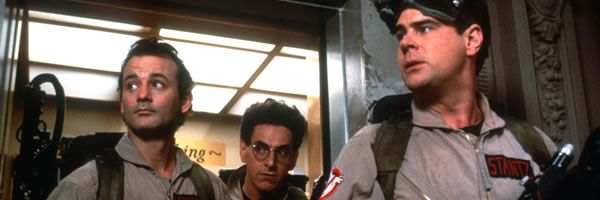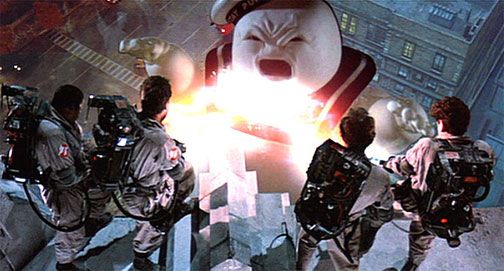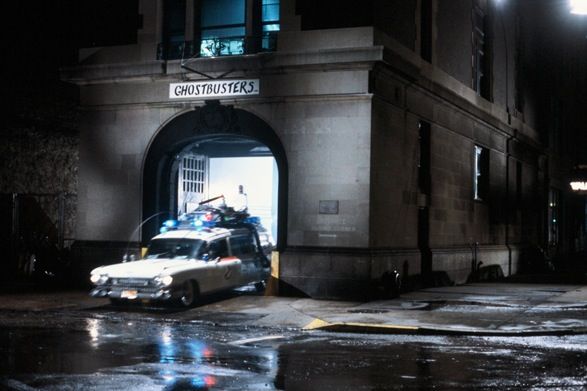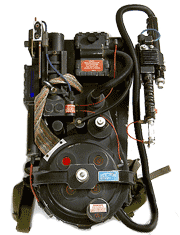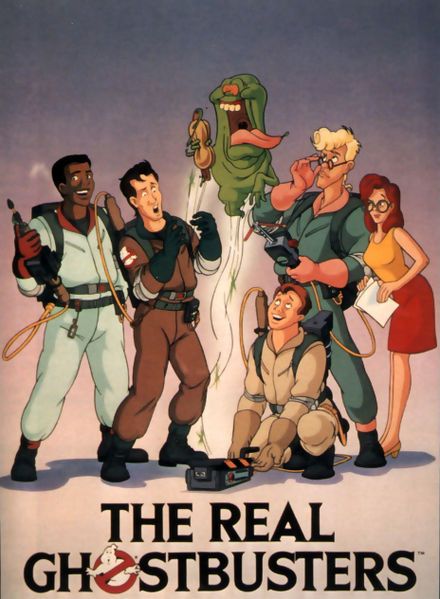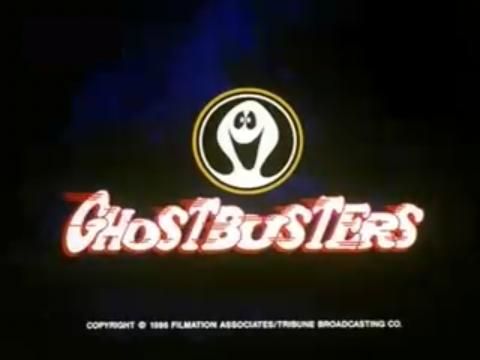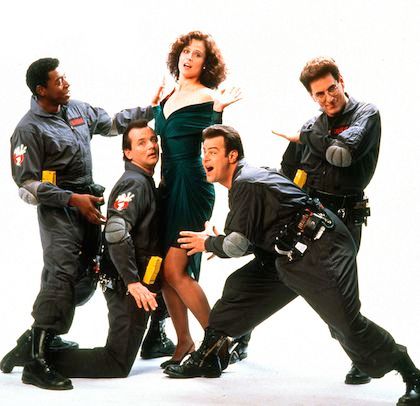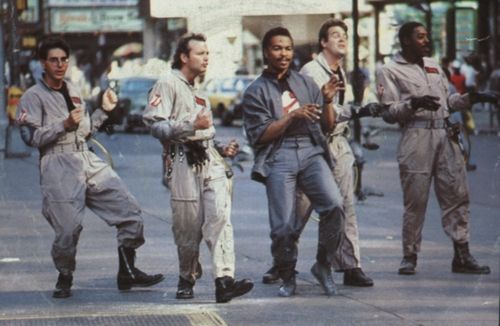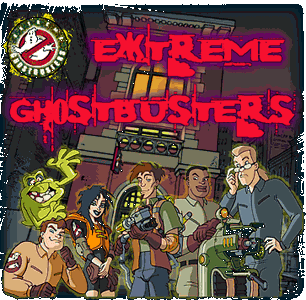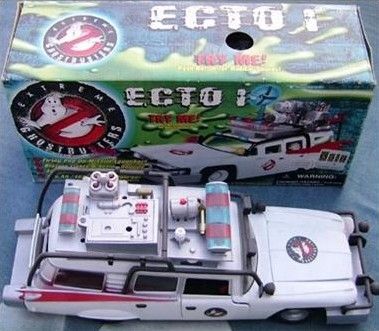If you missed You Know Who to Call Part 2, click here.
“Okay, so, she’s a dog.” And yes, they, “conjured up a hundred-foot marshmallow man, blew the top three floors off an uptown high-rise, and ended up getting sued by every city, county, and state agency in New York. Yeah, but what a ride.” If quotes like these don’t ring a bell, it’s because time has silenced the echoing bell that once brought a team of exterminators to assemble for action in an old ambulance. If it sounds crazy, maybe it was, but they were ready to believe you. Since falling out of business, less and less may have come to believe in them. The Ghostbusters cleaned suites and streets of paranormal activity. The Ecto-1 may need a jumpstart, but let’s take a ride down memory lane after the jump.
It’s May 8, 2013, as I begin to write this. If it was circa 1984, it would be officially known: a) that George Orwell was a little too pessimistic when writing his signature book; and b) that as of today it is exactly a month until Ghostbusters arrives in theaters. Ghostbusters wasn’t based on any source material. It was based on something a little rarer: original material.
The concept was inspired by Dan Aykroyd's own fascination with the paranormal and it was conceived as a vehicle for himself and friend John Belushi, another fellow Saturday Night Live alumnus and the other half of The Blues Brothers. Tragedy struck early on to curtail that plan. Akyroyd was sitting in a production office, at 150 Fifth Avenue on March 5, 1982, writing a line for Mr. Belushi’s character when he received the call: his dear soul man was dead in Los Angeles. The news hit fans, friends and family hard. But as always, the show must go on. It had to go on as ideas of passion never loosen their grip.
“We’re ready to believe you." - The Ghostbusters
As written by Aykroyd, his concept was different from what was eventually filmed. In the initial version, a group of Ghost Smashers traveled through a mix of space, time and dimensions combating the paranormal which engulfed the environment wherever they arrived. The actor-to-be-known-as-Stantz pitched his story to director Ivan Reitman. You can maybe imagine Reitman nodding at points and then saying how he likes the basic idea, followed by a dreaded, “But…” Sure enough, he immediately saw the budgetary impossibilities in the first draft. At his suggestion, Harold Ramis, who Reitman had worked with on Stripes, was brought on to skillfully ground the fantastic elements of the high-concept premise. Aykroyd and Ramis hammered out the script over three weeks in a Martha's Vineyard bomb shelter in the summer of 1982.
Casting had to be set. With Belushi dead, the role of Peter Venkman went to former Saturday Night Live cast member and current rising star Bill Murray, who Retiman had earlier worked with on 1979’s Meatballs. Rising star Eddie Murphy ended up being too busy with Beverly Hills Cop to put in any teamwork on Ghostbusters. As for Louis Tully, who was originally conceived as a conservative man in a business suit played by comedian John Candy, commitment issues lead the way for Rick Moranis to step in and provide a new beat of nervous, geeky comic humor. Gozer would end up being filled by a skin-tight-costumed Yugoslav model by the name of Slavitza Jovan, replacing the original plan of Ivo Shandor as a slender man in a suit played by Paul Reubens. But while Jovan triumphed with her figure, her voice and accent didn’t cut it. The demonic voice of Gozer was provided by Paddi Edwards in the final cut.
The changes and polishing of the plan for the movie didn’t stop in the casting department. Over in the storyboarding room, the Ghostbusters wore SWAT-like outfits and riot squad helmets with movable transparent visors, and used wands instead of Proton Packs to fight the ghosts. All came together when the film score was composed by Elmer Bernstein, notable for his use of synthesizers and, his 1980’s staple, the ondes Martenot. So with all that, could anyone have confidently predicted which way the movie would go with moviegoers? It did well with test audiences, but it’s always the box-office that is the final and ultimate test. Roberto C. Goizueta, the then chairman of Coca-Cola, which owned the studio, was skeptical of Ghostbusters digging itself into a gold mine after a cost of $30 million. Sure, it was a movie not closed off to segments of the market, as all ages could enjoy the movie, but there was a consensus with critics that big effects largely ruined comedies. Add to that, Columbia Pictures hadn’t had a hit since 1982’s Tootsie. Only half the paranormal-exterminating team was familiar to audiences, so would anything change in 1984 with an action-comedy mesh? Let’s visit the weekend after Ghostbusters’ release day: June 8, 1984. Theaters are open and accepting patrons. What will the weekend and beyond hold in store?
“We got one!” -Janine Melnitz
Specifically: a $13.6 million take on opening weekend, a studio record of $23 million in its first week, a #1 position at the box-office for five consecutive weeks, grossing $99.8 million in that time. After seven weeks at the top of the leader board, it was finally knocked to second place by the debut of Prince's Purple Rain. But by then it had grossed $142.6 million, second only to Indiana Jones And The Temple Of Doom as the year's top moneymaker. Then came a reversal of direction in the box-office race: Ghostbusters regained the top spot the following week.
The movie went on to gross about $229 million at the domestic box-office, making it the second highest-grossing film of 1984, behind only Beverly Hills Cop. That figure put it within the top ten highest-grossing films of all-time. A re-issue in 1985 gave the film a total gross of $238.6 million, officially surpassing Beverly Hills Cop and out-sliming all to make Ghostbusters the most successful comedy of the 1980’s with earnings of $238.6 million domestically.
Assisting the film’s triumph was its theme song written and performed by Ray Parker, Jr., and sparking the catchphrases, “Who you gonna call?” and, "I ain't afraid of no ghost." The song was a huge hit, staying #1 for three weeks on Billboard's Hot 100 chart and #1 for two weeks on the Black Singles chart. The music video with Ray Parker Jr., directed by Ivan Reitman and starring actress Cindy Harrell, had its fair share of celebrity cameos with the likes of Chevy Chase and even John Candy popping in to answer, “Ghostbusters!” The song earned Ray Parker Jr. an Academy Award nomination for Best Original Song. It lost to Stevie Wonder’s I Just Called To Say I Love You from The Woman In Red, but it won hearts and minds in pop culture and an iconic status in history crossing the fields of music and film.
Ghostbusters propelled all of the film’s stars to a new level of fame and brought an undermined genre respect. Luckily for us, the movie thoughtfully combined sly humor and blockbuster special-effects by taking each seriously, a skillful task, and having fun with them both like a delicate ballroom dance between dramatic bulls. The use of adults made the suspension of disbelief quite easy for all ages in America put under the spell of Ghostbusters in 1984. There was a maturity put to this wide-eyed dream of ridding rooms of ghosts for a living that adolescence could never capture and a juvenile mind could latch on to. Yes, kids became pseudo-scientists when the details of the wondrous technology used by the Ghostbusters served to be accessible. All was able to be understood like a researcher explicating his groundbreaking invention and his or her peers following the process that is so theoretically simple and yet so practically provoking. Every child growing up loved instances that left it up to them to teach Mom and Dad about topics to which parents had only ignorance to offer. While fractions were just being taught at school and sex education was still a few years off, nuclear devices were something the kids could excel in.
So during dinnertime, it played out as a little boy, for instance, illustrating a blueprint of the Ghostbusters’ primary tool-of-trade on his dinner plate with mashed potatoes, snap peas and evil Brussels sprouts as the paranormal culprit, while simultaneously educating:
“The Proton Pack consists of a handheld Neutrino Wand, also commonly referred to as a Proton Gun, connected by hose to a backpack-sized nuclear accelerator. A particle accelerator propels said particles to high speeds and contains them in well-defined beams. And so, the pack functions like a complex mobile positron collider, smashing high-energy positrons together to generate an excess amount of charged protons. The blasting component fires the by-product of this process in the form of a positively-charged stream of protons that polarizes the negatively charged energy of a ghost, allowing it to be held in the stream like a lasso. The proton streams produced by the devices are semi-controlled; meaning they are concentrated in direction, but still volatile. Beware as unpredictable effort will still be needed to wrangle your entity into an optimal position to finish the job. Operated by a remote pedal, the complimentary unit known as a Ghost Trap emits a force field that vacuums the apparition into the confines of the trap to be held indefinitely. Practice makes perfect, but congratulations: you’re on your way to becoming an honorary Ghostbuster. Oh yeah, and an important safety tip: don’t cross the streams. Crossing the streams can result in total protonic reversal; causing all life as we know it to stop instantaneously and every molecule in a user's body to explode at the speed of light. As I said: important safety tip.”
All of to which Mom and Dad would freeze in shock with their mouths possibly gaping and their eyes certainly popping. Or they’d maybe squeeze my cheek and stir the hair on my head like a pooch. Parents are adorable that way: how little they’ve always comprehended about the goings-on of an aspiring Ghostbuster.
As for the suspicious gold mine, the franchise burgeoned as a bonanza. Produced by Columbia Pictures Television, DiC Enterprises, and Coca-Cola Telecommunications for a limited time until it was folded into Columbia, The Real Ghostbusters was an animated take that ran from September 13 of 1986 to 1991. “The Real,” was added to the title after a dispute with Filmation and its Ghost Busters property, which had been a live-action show from 1975. When Columbia Pictures started producing the film Ghostbusters, it neglected the fact that Filmation had already produced a live-action comedy series with that same name in 1975. Columbia agreed to license the name from Filmation for $500,000 plus 1% of the profits. As per Hollywood accounting practices, Filmation would never get anything from the profits because there were none as far as the balance sheet was concerned.
After the movie came out, there was some room to reteam in the cartoon world. Filmation mistakenly never asked for the animation rights as part of their early settlement, but Filmation and Columbia tried working together to produce a cartoon based on the feature film. The proposed deal eventually fell through and a duel began. Columbia moved forward with DiC Enterprises and Filmation tried to capitalize on their own by creating their cartoon entitled Ghostbusters, which was based on their live-action show. Columbia retaliated by proceeding to name their cartoon show The Real Ghostbusters to directly distinguish it from the Filmation show. Both shows premiered in September of 1986 only a few days apart. Filmation got the lead with a date of September 8, but most people were unfamiliar with the original show more than a decade old at that point and saw Filmation’s product as a copy. Columbia had won. Filmation’s Ghostbusters lasted for 65 episodes from September to December 5, 1986. The Real Ghostbusters continued the adventures for years of the famous paranormal investigators, their secretary Janine Melnitz and their mascot ghost, with a much-expanded presence from the movies, Slimer.
The show had a considerable list of talent behind it who made well-known careers. Joseph Michael Straczynski acted as writer and story editor on The Real Ghostbusters for a period of time. He’s written many comic books since, won a Hugo Award, and scripted numerous shows, having also won an Eisner Award. He wrote 2009’s The Changling starring Angelina Jolie and directed by Clint Eastwood. Ernie Hudson was the only original actor to audition to voice his character, but he would end up losing the part to talk-show-host-to-be Arsenio Hall. Without a noted background, Ernie Hudson had been sidelined from much of the marketing and promotional materials early on for the movie. The studio went with focusing on the first three actors for posters more often than not. Arsenio Hall continued the role of Winston Zeddemore until Buster Jones (Transformers) took over voicing duties in Season 4 until the very end. Egon Spengler was voiced by Maurice LaMarche (Futurama), Ray Stantz/Slimer by Frank Welker (Animaniacs) and Louis Tully by Rodger Bumpass (SpongeBob Squarepants). Lorenzo Music (Garfield And Friends) and Laura Summer voiced Peter Venkman and Janine Melntiz respectively for the first two seasons until Kath Soucie (Handy Manny) took over Janine and Dave Coulier (Full House) managed Venkman from Season 3 to 7.
Although the Ghostbusters concept was tinkered with, the finalized show did feature many tie-ins from the films. The Stay Puft Marshmallow Man and Walter Peck made appearances with Gozer mentioned repeatedly. The uniforms, from beige to color-coded, character looks and containment unit were redesigned, and Slimer was reframed from a bad ghost to a lovable resident and friend explained in one episode, although he would still continue to be a pesky character. In the third season, some of the character designs were modified a little further in shape, style or size in regards to Ray Stantz, Slimer and Janine Melnitz. At the start of the series' third season in 1988, it was re-titled to Slimer! And the Real Ghostbusters. The opening was completely redone to revolve around slimy apparition. Eventually the episodes were expanded from their original half-hour format to last an hour, and the overall feel of the show was changed in exchange for a more youthful and lighter tone.
The Real Ghostbusters on its own spawned comics and a popular toy line of figures and role-playing gear manufactured by Kenner that would run for years alongside the show. The toys were expansive and kept Ghostbusters alive. Ironic that the animated show had a more impressive list of toys than the movie itself did, but it was around longer. Heck, Heinz even had a canned pasta soup branded after it that stayed in production well into the 1990’s past the stamina of original scripted material. The franchise wasn’t one spawning film after film. But with so much success on screens in multiplexes originally and then homes, Columbia Pictures was thirsty for a sequel. Its principals and creators were a little less enthusiastic at first. This wasn’t a franchise thought of from the start as a continuous stream. The first movie was designed to be conclusive, had supercharged success and no one wanted to run its legacy into the ground. Eventually, the writers went back to work, the cast began signing on to have some more fun and Ivan Reitman came back to direct. The gang was back.
In 1989, audiences revisited the Ghostbusters. After exorcising Gozer from Central Park West and escaping the gooey onslaught of the Stay Puft Marshmallow Man, they had ended up being sued for the destruction they were blamed to have wrought; they went through bankruptcy, and a Federal restraining order forbidding them from performing any more ecto-exterminations. Egon Spengler was now back at Columbia University, Ray Stantz was running an occult bookstore and Peter Venkman was the host of a cheap paranormal-themed talk show. Ray and Winston Zeddemore were also doing events and parties under their business’ brand on the side, but their popularity wasn’t what it used to be. Youngsters barely knew who they were. Dana Barrett broke off her romance with Dr. Venkman and had a baby who would become the primary focus of Vigo The Carpathian.
Anticipating a second tsunami of fandom, a major marketing and merchandising push was implemented on all fronts to exploit the glory of 1984. With coloring books, comics and kids meals, nothing was off-limits as video games were released as late as 1990. Holding on to the first theme song, a fresh one was also co-written by Ray Parker Jr. and recorded by Run–D.M.C. Though an attempt to be hipper amongst a growing rap movement, it wouldn’t make as big of a splash in pop culture as Ray Parker Jr.’s hit.
The second film turned in an extravagant profit after starting its run by making more than double what the original did on opening weekend and ending with about $215 million at the worldwide box-office. International audiences boosted their dollar value contribution by double from the original go, but the film nonetheless ended up pale in comparison to the original like the customers themselves that make the call for the Ghostbusters. The final tally at home for Ghostbusters II was a little over $112 million, healthy like an Olympian, but less than half of the first movie’s domestic take. Did the June 16th release not do the movie, set near New Year’s, any favors? Was the film just a less-exciting companion that didn’t offer much except replacing Stay Puft with the Statue Of Liberty in the finale? Maybe too much was left on the cutting room floor: like a deleted segment that had Ray Stantz possessed and maniacally driving the Ecto-1 to kill, only to eventually be socked by Winston Zeddemore and have the car skid into a tree. They did use some shots of that driving sequence in the montage after the court scene. Or was the franchise just naturally grinding slower after saturating the marketing for half a decade? Take your pick.
More video games were released well into the early 1990’s. The Real Ghostbusters continued original business on ABC until September 28th of 1991 after seven seasons and, with the subseries Slimer, 147 episodes. Then syndication took full control. Mr. Aykroyd was eager to start on a third film and has teased it for decades that followed, but his first drafts of a screenplay failed to drum up much excitement behind the scenes. From that point on, the brand went from fading to languishing.
“You're more like a game show host.” -Dana Barrett
Merchandising and licensing has been a widespread part of the Ghostbusters franchise. It’s difficult to say what has kept the brand visible. Has it been cult-classic fans’ sizable, and thus, profitable need to be satisfied or products that keep popping up and keeping it alive by hoping to spark a massive retro-resurgence? Maybe a little of both.
Personally, I was raised a little after Ghostbusters was in its prime. Having been born in 1988, it wasn’t until 1990 that I really began having any memories start piling up, so I caught the tail-end of it all. I’m a child of the 80’s who grew up in the 90’s. Having grown up in the 90's I ran on TV reruns and films of the 80’s that channels liked repeating because new movies were expensive or impossible to air, and the 1980’s were older and not too old. It’s repetition that really made 1980’s entertainment classic entertainment. It had hit a mature standard in visual effects and style, and home audiences ran with it. It felt comfortable. You have no idea how frustrating it was to growing up hooked on a franchise that wasn’t having toys being produced in the same volume as before. Then in the summer of 1997, I swear I thought my eyes to be deceiving me: advertising for something called the Extreme Ghostbusters to start on September 1? How ridiculous, but no, this was TV, it had to be true. It was.
The decision to create a ne
w Ghostbusters TV show was taken seriously in commitment in an aim to reinvigorate a lucrative franchise. The team that helmed Extreme Ghostbusters consisted of many producers and writers that had done work on The Real Ghostbusters. As a result, the show was conceptualized as an explicit sequel to its predecessor. Rather than a series reboot, the makers opted for a realistic passage of time. This was the genius of the show and really was a hook for old fans, bringing it credibility. The updated and darker tone was reflected by the use of a gritty, rock-inspired variation of Ray Parker Jr.'s original song as the opening theme written by Jim Latham.
Set years after the end of The Real Ghostbusters, lack of supernatural activity had put the Ghostbusters out of business once again. Each member had gone their separate way, except for Egon Spengler, vocally reprised by Maurive LaMarche. He had left it to himself to become a slave to the old days, living in the firehouse to monitor the containment unit, furthering his studies and teaching a class on the paranormal at a local college. When ghosts began to reappear, Egon was forced to recruit his lone four students as the new Ghostbusters. The new four consisted of Kylie Griffin, a gothic occult expert; Eduardo Rivera, a cynical Latino slacker; Garrett Miller, a young paraplegic athlete; and Roland Jackson, a square and studious African-American machinery whiz. Rounding out the cast was Janine Melnitz, the Ghostbusters' previous secretary returning to her old job, and Slimer.
Unlike Egon, Janine Melnitz had new voice pedigree fill her shoes. That job was given to Pat Musick (An American Tail). The rest of the cast was seasoned in their own regards too. Slimer was brought vocal life by Billy West (Space Jam). The team itself had Tara Strong (The Real Adventures Of Johnny Quest) as Kylie Griffin, Jason Marsden (Boy Meets World) as Garrett Miller, Rhino Romano (Sailor Moon) as Eduardo Rivera and Alfonso Ribeiro (The Fresh Prince Of Bel-Air) as Roland Jackson. The show explicitly tied in with episodes from The Real Ghostbusters. But most notably was the two-part season---and subsequently series---finale, which featured the original Ghostbusters getting back in the saddle to team up with their successors. The original voice cast returned in its entirety.
But I was talking about merchandising, wasn’t I? Well, you can’t talk about Extreme Ghostbusters without talking about merchandising. The toy line from Trendmasters made this show notable. They were expecting a heavy-hitter on their hands with this show. While no one got that, die-hards received a respectable extension of toys. Within the series, the tools of choice were upgraded. The Proton Packs and, most obviously, the Particle Thrower were changed to accommodate a loading of proton charges that would eject when they were empty. A spare canister would hang from the back of the pack for such a situation. In order to correlate with the augmented proton charge, the ghost trap also had to be adjusted. The size increase resulted in one person being in charge of the pack, with Kylie Griffin carrying it on her back and handling a smaller Proton Pistol.
What worked in the series’ equipment-wise didn’t result in an amazing toy equivalent from Trendmasters. Both the Proton Pack and Ectoplasmic Containment Unit With Positron Blaster turned out flimsy to carry, work with and wear. The Ecto-1 was more successfully a nice throwback, but it’s really the action figures that were the highlight. The wheelchair-bound character of Garrett Miller didn’t make it past the prototype stage upon the first series release. Egon, Roland, Kylie and Eduardo got their shot in the limelight equipped in the usual gear alongside higher-priced variants labeled as deluxe editions with lights, sound effects and oversized blasting equipment. The smaller versions, unlike the deluxe ones, each came with an identical ghost trap, an individual ghost miniature and shooting action. They were vibrant and substantial. Trendmasters aimed for a third tier of figures, Extreme Ecto Edition, to include: Eduardo with a Ghost Blastin’ Buster Bike and Roland’s Ghost Grabbin’ Gyro-Copter. Neither got a widerelease and their releases in the UK and not North America became an online bit of trivia afterward.
Because Ghostbusters aren’t much without ghosts to bust, four separate and larger ghouls were released to accompany the other figures: Slimer, Sam Hain, Mouth Critter and Ghost House. All of them, although pretty foremost, had their share of consistent design defects. Was something bound to give if they were going to look as good as they did? The impact of those defects on the whole was minimal. Slimer was oversized with a spinning action and missiles in the shape of food that didn’t quite work as projectiles. The shooting items were too heavy and could never get major distance. Sam Hain was interesting as it was a known character in the franchise bible that never appeared in the story arcs of Extreme Ghostbusters, only in the opening introduction. The figure held a marvelous whip and a heavy pumpkin on its head with a spring that never worked much either to stay on fully or launch wonderfully. The Mouth Critter worked better with an opened mouth protruding from the top that shot a projectile unless it got caught between the teeth for you. The House Ghost had an unreliable shooting eye that didn’t have the problem of blasting unsuccessfully. On the contrary, it might shoot off prematurely on its own. The inner mechanism didn’t quite latch on perfectly. You were better off just loosely inserting the eye while on display. On the upside, this was the only toy to come with its own bottle of ectoplasm.
Despite the flaws of the paranormal portion of characters, all the figures were of a durable plastic and detailed beautifully for display even if they didn’t necessarily excel in their individual action functions. The translucency found in some of the ghosts and the packs of the deluxe figures were fun and worked excellent when light filtered through them. They embodied the original spirit and could easily work alongside your old figures as the next generation. As for the old team, they didn’t get their shot at new casts for toys. From series to shelf, Extreme Ghostbusters was a lovely homage that deserved a longer run. It would end there after 40 episodes on December 4, 1997.
The very first comic book series based on the franchise was The Real Ghostbusters. The rights to the property were shared by NOW Comics and Marvel Comics, with the former publishing in North America and latter publishing in Europe through their Marvel UK imprint. NOW Library, NOW Video, and NOW Comics started in late 1985 as a sole-proprietorship, which would in 1987 be officially labeled under the umbrella of Caputo Publishing, Inc. The comic book division specialized in purchasing the right to publish comic books of recognized characters. In 1986, the year NOW Comics published its first titles, it purchased the comic book rights to Speed Racer. At the time, it was a virtually dead 1960’s intellectual property. NOW Comics paid $1,000 advance on royalties. In June of 1987, the first issue of Speed Racer sold 75,000 copies in two printings. The company knew how to play the game it seemed.
The Real Ghostbusters was another hot property that Marvel or DC would have been happy to take on, but it was NOW Comics that ended up with the permission slip and that certainly helped the company’s further monumental success. The comic book was like a direct translation of its animated cartoon basis and didn’t stray off from a foundational standpoint. The unknown was left to discover through story. The souls of the characters in their individually-colored jumpsuits carried through. Venkman was still the sarcastic mouth of the group; Spengler was the socially-inept brains; Stantz the innocent heart; and Zeddemore the religion of the group. By August of 1988, the Real Ghostbusters comic entered a ruthlessly competitive battleground of dominant rivals. DC had its Batman: Year One and future industry demigod Todd McFarlane had already begun his contribution to the canon of The Amazing Spider-Man. With a pin-up poster in every magazine, a sturdy card stock above the industry standard and coloring formulas, the product was of an obviously elevated standard. That unique standard wasn’t oblivious. It was managed with an issue price of $1.75, above the norm that ranged from below a buck to $1.50, matching the consumer cost of some premium series from major league publishers.
With Ghostbusters under its belt and great credit to it, in a four-year period since inception, Caputo Publishing grew from a one-man operation with annual sales of $110,000 to a multi-million dollar Illinois corporation with presence in a dozen countries. Not a barker’s dozen, mind you: 12 countries. NOW Comics eventually earned the #3 position in the vast comic book world with a market share of 3% behind the veterans of Marvel’s 45% and DC’s 25%. Sound small? Well, think of it as 3% of a billion dollars. Three percent may not seem much when you read it like that, but it’s still three million in those terms. NOW Comics produced almost 1,000 publications since 1986 until the end. Caputo Publishing was also intensive with their cross-promotional ventures such as The Real Ghostbusters cereal from Ralston Purina and the Ecto-Cooler branded Hi-C fruit drink from Coca-Cola with Slimer on the label. The licensed drink would prove lucrative beyond the run of the show and comics, outliving the dead into the 1990’s.
The Ghostbusters publishing history has been sporadic. It started off in 1988 and ceased operations in the 1990’s as NOW Comics may have grown too fast for its own good. After excelling as an upstart, a downswing occurred and the company hiccupped, filing for bankruptcy in 1991, postponing the continuation of The Real Ghostbusters comic until near the end that year. The company got an infusion of millions and renamed itself the NOW Entertainment Corporation. It would struggle until its eventual demise in 1994; two years after The Real Ghostbusters ended its run in December of 1992.
Then in 2004 via new-kid-on-the-block 88MPH Studios, to coincide with the 20th anniversary of the franchise, Ghostbusters: Legion was launched as a four-issue mini-series. But 88MPH Studios didn’t have the same Midas touch. With the hype that came with five promotional pieces of artwork, the mini-series was nonetheless plagued with delays of months between the first and second half of issues. Another complaint was the heavy use of variant covers. There were 13 different covers across the four issues, with the first issue alone having six different ones. Ghostbusters: The Zeddemore Factor was originally intended as a 0 issue to have been released before Ghostbusters: Legion, but it was instead rebranded as one-shot story released at the San Diego Comic-Con as a convention exclusive to help promote the comic at the stall of 88MPH Studios.
An ongoing series beyond Ghostbusters: Legion was announced and planned with covers penciled and colored, but licensing and financial difficulties had it ultimately go into indefinite hiatus. Long enough without a single bit of news in the marketplace, it was eventually cancelled by default. The following synopses have survived through the magic of copying and pasting from the now defunct 88MPH Studios website:
Ghostbusters Monthly #1 - In June 1984, GHOSTBUSTERS exploded into theaters and captivated a generation. Twenty years later, the boys are back in a brand-new ONGOING comic book series. Now that they’ve saved the world twice, the Ghostbusters want to go global…but that’s easier said than done. Meanwhile, a dead man is wandering the streets of New York and something wicked stirs in the Central Park Zoo. Old foes, new enemies and trusty unlicensed nuclear accelerators, this exciting first issue has it all. Because even after two decades, you know who to call.
Ghostbusters Monthly #2 - Romance is in the air as Egon and Janine go out on their first official date, and with Peter playing the role of Cyrano things are bound to get interesting. Meanwhile, Winston goes solo, Louis gets an unwelcome visit from an old friend, and Ray takes a trip to a dark, dangerous place…the library.
Ghostbusters Monthly #3 - With the powerful ghost known as Ahriman making trouble and Vinz Clortho back for an encore, the Ghostbusters find themselves racing from one disaster to the next. And that’s before things get really bad. It turns out there's one thing worse than having two evil spirits rampaging through New York; when they get together.
Where the 88MPH Studios project failed in marketing and production, it succeeded in showing what was possible. The artwork and writing were a modern take on the franchise, updating the old characters for a new time with a fresh style. Sure, 88MPH Studios went out of business, but so had the Ghostbusters twice before.
Look for the second part of a detailed history of the GHOSTBUSTERS in the coming days.

